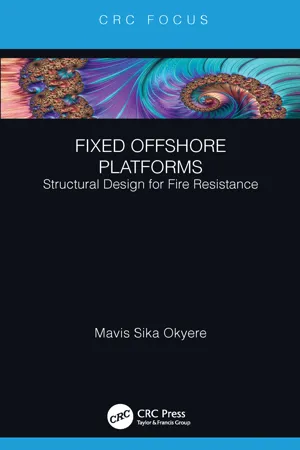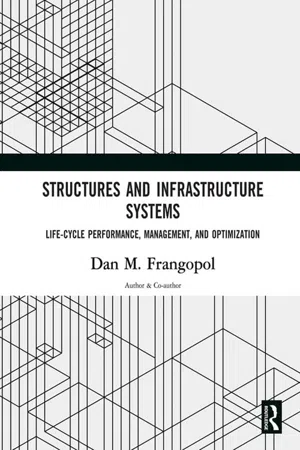Fatigue Design
Fatigue design involves predicting and managing the failure of materials and structures under cyclic loading. It focuses on understanding how repeated stress can lead to cracks and ultimately failure, and aims to develop designs that can withstand these fatigue effects over the expected lifespan of the product. This is crucial in ensuring the safety and reliability of engineering components.
5 Key excerpts on "Fatigue Design"
- Mavis Sika Okyere(Author)
- 2018(Publication Date)
- CRC Press(Publisher)
...8 Fatigue Analysis Fatigue is the weakening of a material caused by the repeated application and removal of stress. For example, if you bend a piece of metal back and forth repeatedly in the same spot, fatigue will result at the bend location and will weaken the metal until it eventually breaks. Technically, platforms experience fatigue as a result of periodic increases (application of stress) and decreases (removal of stress) in operating pressures. Because fatigue can cause a failure to occur at stress levels well below those that a material can withstand in a single, nonrepetitive loading, materials that must resist repeated stress cycles must be specially designed for this service. Durability is the ability of the material to resist fatigue. Fatigue analysis is done to ascertain the offshore platform structural response to continual wave loading. Fatigue analysis is carried out using the deterministic method or spectral method. Use the S – N curves to determine fatigue cycles. Also calculate the fatigue stress or fatigue damage. A detailed fatigue analysis should be performed for all structures as recommended in Section 5.2 of API RP 2A. The fatigue analysis is performed with input from a wave scatter diagram and from the natural dynamic response of the platform and the stiffness of the pile caps at the mud line by applying the Palmgren-Miner formula. Miner’s rule is probably the simplest cumulative damage model. It states that if there are k different stress levels and the average number of cycles to failure at the i th stress, S i, is N i, then the damage fraction, C, is C = ∑ i = 1 k n i N i (8.1) where n i = the number of cycles accumulated at stress S i C = is the fraction of life consumed by exposure to the cycles at the different stress levels...
- eBook - ePub
- Julian Happian-Smith, Julian Happian-Smith(Authors)
- 2001(Publication Date)
- Butterworth-Heinemann(Publisher)
...In: The evolution of fatigue crack initiation life prediction methods. Proceedings of Fatigue 81, Soc. Environmental Engineers; Westbury House; 1981:3 ISBN 086103 0427. Musiol C, et al. Advances in computer aided design against fatigue. 1981 C234/81. Neale MJ. Component failures, maintenance and repair. A Tribology Handbook. Newnes-Butterworth; 1975 ISBN 0408000821. Niemand LJ, Wannenburg J. In: Vehicle durability programmes. EIS; 1997:22 Issue 2, July. O'Connor P. Practical Reliability Engineering. John Wiley; 1981 ISBN 0471926965. Open University. Open University Visual Aids, T353, Last of the Liberties. 1984. Owen M. In: SPC and continuous improvement. IFS Publications UK; 1989 ISBN 0-94850-795-8. Penter AJ, Lewis DC. Build quality inspection of repaired and new gearboxes. ImechE; 1990 C404/042. Plint and Partners Ltd. Tribology Update. (Issue 6):1997;11. Polushkin EP. Defects and Failures of Metals. Elsevier; 1956 Cat No. 5511998. Pountney R, Dakin J. Road loads for durability using wheel force transducers and component characterisation. EIS Conference on ‘Smarter Testing & Simulation’. Journal of the Engineering Integrity Society. 1998;20 No. 4, July. Powell DE. Vehicle Component fatigue testing. SEECO. 1979;Volume 5:87 May 9-11th. Powell HJ. Resistance spot welding the guest for best practice. Welding & Metal Fabrication. 1995;9 March. Pugh S. Total Design, Integrated Methods for Successful Product Engineering. Addison Wesley; 1991. Pye A. In: Getting your process right. Engineering; 1992:14 September 1992. Reynolds KA. The Role of the Metallurgist in the Investigation of Component Failures and Vehicle Accidents. Journal of Inst. of Automative Eng. Assoc. 1997. Rice RC, et al., eds. Fatigue Design handbook. second edition 1988 SAE. ISBN 0-89883-011-7. Rivett RV. The failure of spot welds in low carbon mild steel. The Welding Inst. Res...
- Anthony Sofronas(Author)
- 2012(Publication Date)
- Wiley(Publisher)
...Engineers need to know what can be done to prevent these fatigue failures when modifications of the springs, masses, forcing function, or damping are not possible. Sometimes the necessary changes are obvious, such as increasing a radius or removing a notch; other times they are not. This is discussed from a practical viewpoint in this chapter. No calculations on how to determine the fatigue life are presented using traditional engineering approaches, as that is available from other sources [2, p. 22; 3], as are crack growth rates. Crack growth has been discussed briefly in several case histories in this book. 12.2 Reduction of a Component's Life When Subjected to Excessive Vibration Although we use the term excessive vibration here, this is now known to mean excessive cyclic stress due to cyclic loads. The endurance limit of a material, a steel alloy in this book, is the alternating stress for which a part will not fail in fatigue. If a paper clip is bent back and forth long enough, it may or may not fail in fatigue. It depends on how much it is bent: the torsional stress, the material properties, the surface condition, and the residual stress due to forming. A rotating beam test is one in which a polished sample with no stress rises or residual stresses is rotated and a reverse bending load of different magnitudes is applied (i.e., a cycling bending stress). The number of cycles until the beam fails are measured. When the beam does not fail after about 10 7 cycles at a given stress level, it is said to have reached its endurance limit and will not fail under that stress or lower stresses. When no other information is available, a rough estimate of the endurance limit for steels is one-half the tensile strength. The tensile strength of the steel in Figure 12.1 is 120,000 lb/in 2. Figure 12.1 Surface factors affecting the endurance limit. Figure 12.1 represents a typical steel with a tensile strength of 120,000 lb/in 2...
- eBook - ePub
Fatigue Testing and Analysis
Theory and Practice
- Yung-Li Lee, Jwo Pan, Richard Hathaway, Mark Barkey(Authors)
- 2011(Publication Date)
- Butterworth-Heinemann(Publisher)
...A method for obtaining and analyzing sensitivity data. Journal of the American Statistical Association. 1948;Vol. 43:109–126. Dowling N.E. Mechanical Behavior of Materials: Engineering Methods for Deformation, Fracture, and Fatigue, 2nd ed. New York: Prentice Hall; 1998. Gerber W.Z. Calculation of the allowable stresses in iron structures. Z. Bayer Archit Ing Ver. 1874;Vol. 6(No. 6):101–110. Goodman J. Journal of Mechanics Applied to Engineering, 1st ed. New York: Longmans, Green; 1899. LBF TM No 50/70. Haibach E. Modifizierte Lineare Schadensakkumulations-hypothese zur Berücksichtigung des Dauerfestigkeitsabfalls mit Fortschreitender Schädigung. New York: Lab fur Betriebsfestigkeit Darmstadt, FRG; 1970. Haigh B.P. Experiments on the fatigue of brasses. Journal of the Institute of Metals. 1917;Vol. 18:55–86. Heywood R.B. Designing Against Failure. Chapman & Hall; 1962. Horger O.J. ASME Handbook: Metals Engineering — Design, 2nd ed. London: McGraw-Hill; 1965. JSME S 002-1981Japan Society of Mechanical Engineers. Standard method of statistical fatigue testing. 1981. Johnson R.C. Specifying a surface finish that won’t fail in fatigue. Machine Design. 1973;Vol. 45(No. 11):108. Juvinall R.C. Engineering Considerations of Stress, Strain, and Strength. New York: McGraw-Hill; 1967. Juvinall R.C., Marshek K.M.. Fundamentals of Machine Component Design, 3rd ed., New York: John Wiley & Sons, 2000:314 Kececioglu D.B., Robust Engineering Design-by-Reliability with Emphasis on Mechanical Components & Structural Reliability, Vol. 1. New York: DEStech Publications, 2003:185–218 Krause D.E.. Cast iron—a unique engineering material, ASTM Special Publication 455. American Society for Testing and Materials, 1969:3–29 Kuguel R.A.. Relation between theoretical stress concentration factor and fatigue notch factor deduced from the concept of highly stressed volume. American Society for Testing and Materials Proceedings, Vol. 61. 1961:732–748 NASA TN D-125 9Kuhn P., Figge I.E....
- eBook - ePub
Structures and Infrastructure Systems
Life‐Cycle Performance, Management, and Optimization
- Dan M. Frangopol, Dan M. Frangopol, Dan M. Frangopol(Authors)
- 2019(Publication Date)
- Routledge(Publisher)
...For this reason, service life prediction for fatigue has to be carried out in design and assessment phases. In general, fatigue life can be assessed based on the stress–life (S – N) relationship (as a model of fatigue resistance) and the action of sea waves and the sea environment (as a model of fatigue loading), as suggested by Ayyub et al. (2002a). If the S – N category of the structural detail is correctly classified, the necessary information regarding fatigue resistance can be easily obtained. However, the accurate estimation of fatigue lifetime sea loads may be more challenging in time-dependent fatigue deterioration processes due to various uncertainties. These uncertainties include still water loading, wave-induced loading and transient impact-slamming, among others. Clearly, in Fatigue Design, experiments or simulations for predicting the potential lifetime sea loads are useful. Similarly, in fatigue assessment, structural health monitoring (SHM) during voyages provides real-time fatigue loadings that can be integrated into a time-dependent structural performance assessment. However, continuous monitoring up to the anticipated service life may not be feasible. This is because there can be many restrictions due to budgetary, environmental and operational constraints. Alternatively, a probabilistic approach for fatigue life evaluation can be used to effectively estimate lifetime sea loads based on given information obtained from model tests, simulations or monitoring. To date, the use of simulations, model tests and monitoring programs has been widely accepted for the estimation of lifetime sea loads. Kaplan et al. (1974) conducted a study with the computer program SCORES in order to estimate wave loads on the SL-7 container ship. The key factors of their study were ship speeds, wave lengths, headings and sea states...




